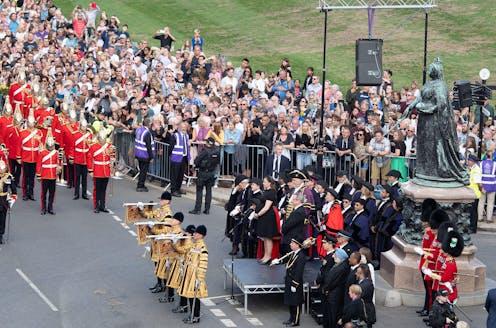
When Queen Elizabeth II passed away on September 8, 2022, there can’t have been many people in the UK who hadn’t heard about it within hours of her death. The media was on high alert from around midday, when an announcement from Buckingham Palace made clear that the monarch’s health was under threat.
The BBC replaced normal programming with rolling news coverage. And as soon as the announcement of the Queen’s death was posted on the gates of Buckingham Palace, just before 6.30pm, news presenters interrupted programmes across the board to inform the public. The news, after all, is at our fingertips 24/7.
By contrast, when Queen Elizabeth I died in Richmond Palace, near London, on March 24, 1603, the news didn’t arrive in Berwick-upon-Tweed in Northumberland, around 550km away, until two days later. The proclamation that brought news of her death and of James I’s accession took almost two weeks to reach Ireland.
In the days before mass media and high levels of literacy, news travelled slowly. Like our current press, however, early tools for communicating this kind of momentous event trod the same tricky path of celebrating the late queen’s reign, mourning her passing and heralding the new king’s arrival. Striking the right tone to reflect the nation’s grief and commemorate a distinguished life has always been crucial.
How news spread in the 17th century
When Elizabeth I died in 1603, James VI of Scotland became James I King of England and Ireland as well. We know that many people across England, Wales and Ireland found out about this through proclamations, songs and other forms of oral communication.
Research shows how even pamphlets were often designed to be read aloud, for example, by using punctuation to instruct readers when to pause or breathe. They recognised that printed texts were shared socially among groups of family and friends.

These items could be described as the social media of their day. The simple, popular songs known as ballads could be composed and printed within a matter of days. They were easy to distribute and cheap to buy. Above all, they were based on face-to-face communication and public performance.
Fanfares of drums and trumpets of the kind that preceded the principal proclamation of King Charles III at St James Court on September 10, 2022 were also often used to grab people’s attention for the proclamations which were heard in Tudor and Stuart marketplaces.
Ballads were ideal for disseminating this sort of news and information too. Like proclamations, they were performed in marketplaces, but they could also be heard at fairs and in taverns – anywhere where an audience could gather. Though the lyrics were often printed, they mostly spread by word of mouth. And they deliberately used techniques that made them easy to remember, including rhyme, rhythm and repetition.
The chorus of one ballad about Elizabeth I’s death, called A Mournful Ditty, combined repetition, alliteration and rhyme with a melody. It was perfectly crafted for singers to join in:
Lament, lament, lament you English peers, Lament your loss possessed so many years.
A dual focus
These days, of course, it would be rare to learn about a major news event from a song. But the lyrics of that ballad show how the fundamental problems facing the media today on the death of a sovereign were the same 400 years ago.
The immediate focus is on grief. For there to be mourning, there also needs to be a sense that something cherished has been lost. So even while celebrating the peace and stability of her impressive 44-year reign, the ditty praised Elizabeth I as “the paragon of time” and urged its listeners to:
Weep, wring your hands, all clad in mourning
But the death of one monarch marks the accession of another. And the focus of the cheapest print – ballads – quickly shifted to the new monarch. This is probably because James I faced one issue that Charles III does not.

In contrast to Charles III – who is a familiar figure from his many years as the heir apparent – James was, to the English, Welsh and Irish, king of a foreign state. What is more, Elizabeth I had refused to name him as her successor. There were any number of rival claims to her throne.
Several ballads combined mourning the Queen’s passing with introducing the Scottish king to his new subjects. They highlighted continuities, including James’s English ancestry as great-great-grandson of Henry VII.
Pamphlets described his journey from Edinburgh and ceremonial entry into London in detail. One song even went so far as to falsely claim that Elizabeth I had “assigned all her state to our Noble King James”. Presumably this was part of a narrative that smoothed his accession by setting him up as the rightful heir to the throne.
One printed sheet, Weep with Joy, described Elizabeth as an example of piety, humility and mercy whose loss should be lamented. It also noted that James’s accession was a cause for celebration. His proclamation, the pamphlet states, was “read and received with great applause of the people”.
How true this was is debatable. One diarist noted that the proclamation was heard with “silent joy”, though this was in part down to relief that James had succeeded peacefully.
This narrative of continuity can now be seen in the way Charles III’s speeches and statements draw on his mother’s reputation. Although a succession crisis was never on the cards, his accession has been greeted with misgivings by some. Maybe even in the 21st century, the dual focus of news helps to strengthen the bond between the new monarch and the old, smoothing the transition of power even as it creates tensions for the media.
Jenni Hyde does not work for, consult, own shares in or receive funding from any company or organization that would benefit from this article, and has disclosed no relevant affiliations beyond their academic appointment.
This article was originally published on The Conversation. Read the original article.







